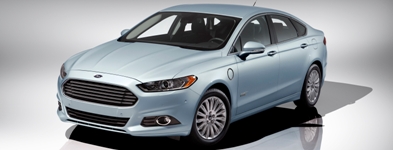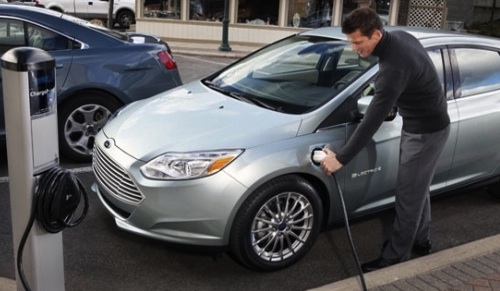With gasoline prices over $4 per gallon in many states, Ford is rolling out a variety of exciting hybrid cars and electric cars.
In April, consumers will start buying the new Ford Focus Electric. Yesterday, I rode in this beautiful compact hatchback. I silently cruised down the streets unless you cranked on the impressive sound system. Drop the 60/40 split backseat and you could put a couple of mountain bikes in the back or a work project or home improvement tools and supplies. With the backseat up, you can seat 5 adults.
Ford is pricing the Focus Electric at $39,200, about $4,000 more than the Nissan LEAF. The 23kW Ford battery pack, with LG Chem lithium-ion cells, charges at twice the speed of the LEAF and has about 10 percent more range. By the end of the year however, the 2013 LEAF will charge at the same rate. Unlike the Focus, the LEAF includes an ECO mode, which may equalize the ranges. The LEAF also includes a DC Fast Charge port while Ford waits for a future SAE Level 3 standard.
Although you might gulp at paying $39,200, savings include a $7,500 federal tax credit, incentives in many states, and saving $1,000 or much more on gasoline. These tax breaks seem unfair to many, but keep in mind that our gasoline is half the cost of Europe due to U.S. subsidies and breaks for the oil industry.
Ford increasingly believes in customer choice. The gasoline sipping Ford Focus SE gets 40 mpg highway and is not even a hybrid. It starts at about $18,300.
Ford C-MAX Energi and Hybrids = Crossover SUVs with Great Mileage
 In the fall of 2012, Ford brings unparalleled fuel economy to the 5-seat crossover SUV segment. The C-MAX plug-in hybrid will allow you to drive the first 20 to 30 miles on a garage electric charge before engaging a fuel-efficient engine. It may rate over 100 mpg. The C-MAX lives up to its name. It maximizes the cargo and passenger space that can be fit on the popular “C” sized vehicle platform. Like the Focus, the C-MAX is a 5-seater. Drop the back seat and you have much more cargo space than the Focus. Price has not been announced. Our guess is that it will be under $40,000.
In the fall of 2012, Ford brings unparalleled fuel economy to the 5-seat crossover SUV segment. The C-MAX plug-in hybrid will allow you to drive the first 20 to 30 miles on a garage electric charge before engaging a fuel-efficient engine. It may rate over 100 mpg. The C-MAX lives up to its name. It maximizes the cargo and passenger space that can be fit on the popular “C” sized vehicle platform. Like the Focus, the C-MAX is a 5-seater. Drop the back seat and you have much more cargo space than the Focus. Price has not been announced. Our guess is that it will be under $40,000.
For customers that want to pay less up-front, Ford will also offer the C-MAX as a hybrid. It will be as roomy as the C-MAX Energi, but never get plugged-in. With a lithium-battery pack it will have excellent fuel-economy. The C-MAX Hybrid will compete head-on with the new Toyota Prius V, which gets 42 mpg combined and has 40 percent more cargo than the best selling Prius Liftback.
Ford Intends to Take Midsized Market Share from Toyota
 When the 2013 Ford Fusion Hybrid goes on sale at the end of this year, it will offer the best fuel economy of any midsized sedan. It is targeted to deliver 46 mpg highway, 44 city, and 46 combined, beating the Toyota Camry Hybrid with its famous Synergy Hybrid Drive System. I have been very impressed with test drives of both hybrids, which are roomy, quiet, and smooth as silk to drive. The Camry uses NiMH batteries; the Fusion Hybrid uses lithium-ion.
When the 2013 Ford Fusion Hybrid goes on sale at the end of this year, it will offer the best fuel economy of any midsized sedan. It is targeted to deliver 46 mpg highway, 44 city, and 46 combined, beating the Toyota Camry Hybrid with its famous Synergy Hybrid Drive System. I have been very impressed with test drives of both hybrids, which are roomy, quiet, and smooth as silk to drive. The Camry uses NiMH batteries; the Fusion Hybrid uses lithium-ion.
Outdoing Toyota, Ford will also offer the Fusion Energi, a plug-in version that will deliver the first 20 to 25 miles of driving on a garage charge before engaging the gasoline engine. Pricing has not been announced. Ford will also emphasize customer choice with the Fusion available with a variety of non-hybrid configurations.
Ford’s Strategy to Lower the Cost of Hybrid and Electric Cars
Ford built 2.5 million “C” platform vehicles last year with many common components. The Focus Electric and C-MAX offerings will be built with over a dozen other vehicles on the same assembly line in Wayne, Michigan. Ford controls cost with flexible manufacturing, where it can quickly adjust to market demand.
Ford’s team of more than 1,000 engineers working on hybrid and electrification programs – including Fusion Hybrid and Fusion Energi plug-in hybrid – has grown so fast that the company today is announcing the conversion of its 285,000-square-foot Advanced Engineering Center in Dearborn, Mich., to electrified vehicle development. The new jobs are part of Ford’s plans to add more than 12,000 hourly and salaried jobs by 2015 in the United States. The company also has announced it is tripling production capacity of its hybrid, plug-in hybrid and electric vehicles in the U.S. next year compared with 2011.
Over 80 percent of the Fusion Hybrid and Energi components will be the same, allowing Ford to achieve more cost efficiencies. With the C-MAX, we will see that Ford powersplit hybrids and blended plug-in hybrids share about 85 percent of the same components including electric traction motor, generator, inverters, DC/DC converters, electric accessories, transmission, and engine. Both the C-MAX Energi and C-MAX Hybrid models, with a common chassis, will be built alongside the all-new 2012 Ford Focus and Focus Electric at Ford’s Michigan Assembly Plant in Wayne, Mich.
Three years ago, lithium battery packs cost about $1,000 per kilowatt. Now the cost is closer to $500. By the end of the decade, costs may only be $250 per kilowatt. Ford makes all of its lithium-packs and works with several lithium cell manufacturers to get the best price and battery chemistries separately optimized for battery-electric, plug-in hybrid and hybrid. Ford’s pack and volume strategy will lower costs of hybrid and electric cars.
Ford will Sell 100,000 Hybrids and EVs with Lithium-Batteries
Lithium batteries are everywhere. They are in your mobile phones, iPads, notebook computers, game players, music players, and a lot more. Soon lithium batteries will be in millions of hybrid and electric cars.
As electric and hybrid car competition intensifies, Nissan, GM, Toyota, and Ford are in a race to sell the most vehicles with lithium batteries. I have driven cars from each of these automakers that use lithium batteries. The cars performed beautifully and delivered great fuel economy.
Toyota is bringing to market three vehicles with lithium batteries – The Prius PHV, the RAV4 EV, and the Scion IQ EV. These three give Toyota a shot at being the first automaker to put 100,000 vehicles on the road with lithium batteries. Toyota has over 3 million hybrids on the road with NiMH batteries. Why fight success? Toyota will be careful in switching to lithium-ion. Economics, reduced vehicle weight, and more interior room will eventually make the switch compelling.
Over 10,000 Nissan LEAFs have been delivered, putting Nissan ahead of the competition in the electric car race. Nissan will deliver up to 50,000 LEAFs globally this year. In 2013, a new plant opens in Tennessee with the ultimate capacity of 150,000 LEAFs per year plus 200,000 lithium battery packs per year.
General Motors and LG Group are jointly designing and engineering future electric vehicles, expanding a relationship built on LG’s work as the battery cell supplier for the Chevrolet Volt and Opel Ampera extended-range EVs. In 2012, GM will deliver up to 60,000 Volts and Amperas with LG Chem advanced lithium battery cells.
Ford will only use lithium batteries in all Ford hybrids starting in calendar year 2012 when it announces the new Focus using the Ford global C platform. Ford is currently second only to Toyota in global hybrid sales. Ford may be the first car maker to sell 100,000 cars annually that includes lithium batteries. When I lasted interviewed Nancy Gioia, Director Ford Global Electrification, she said that Ford has a 2020 goal of 10 to 25 percent of its vehicle sales including lithium batteries. Her best guess is that 70% would be hybrids, 20 to 25% plug-in hybrids, and 5 to 10% battery-electric. Everything from technology innovation to oil prices will affect the future mix.

